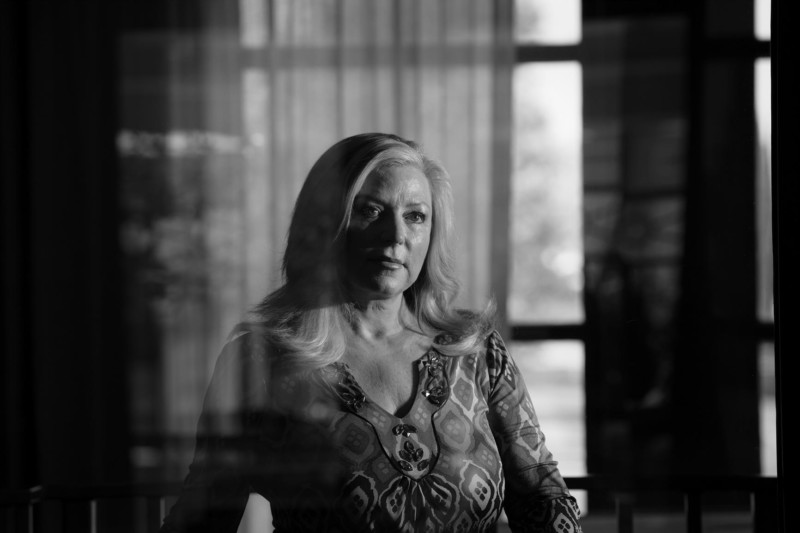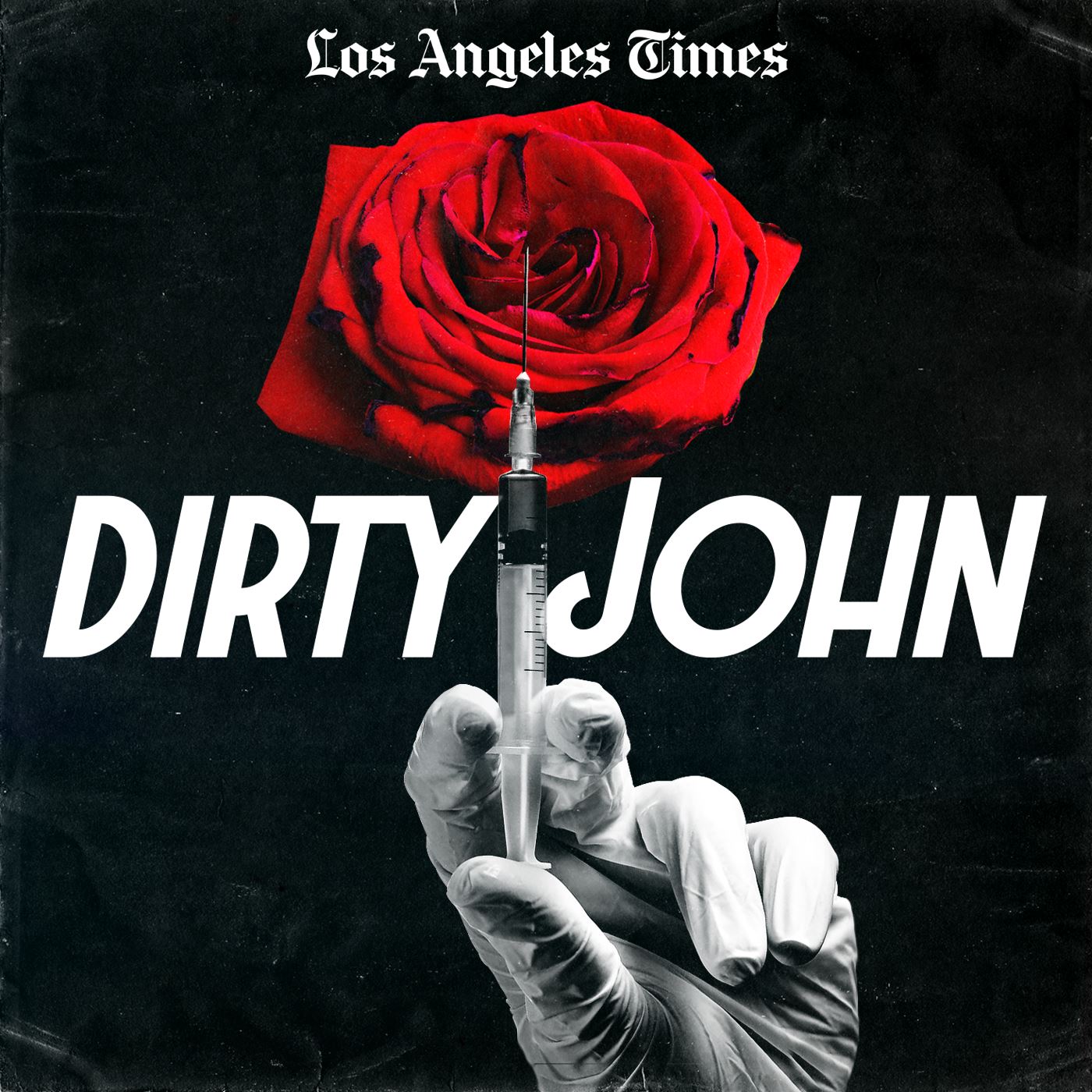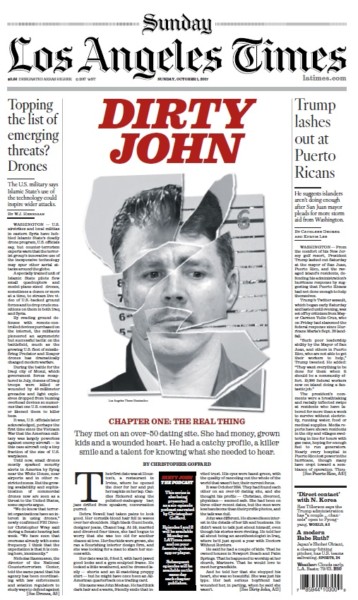Sign up for The Media Today, CJR’s daily newsletter.
With its first foray into narrative podcasting, the Los Angeles Times has a hit. Dirty John, a psychological-thriller-slash-true-crime story told in six installments by the Times’s Christopher Goffard, has already been downloaded more than seven million times (and grabbed more than one million unique visitors to the print version) since its debut at the start of the month. Produced in partnership with Wondery, the print-and-audio collaboration tells the story of Debra Newell and John Meehan’s toxic relationship, touching on themes of love, betrayal, deception, and domestic violence.
The plot of the print story and podcast follow roughly the same outline, with one major exception: The first episode of the podcast opens with an Orange County assistant district attorney reading from an autopsy report, describing a series of stab wounds in clinical detail. In print, on the other hand, readers are welcomed, in media res, to a more quotidian scene:
“Their first date was at Houston’s, a restaurant in Irvine, where he opened the door for her and put her napkin on her lap.”
ICYMI: NBC journalist’s harassment allegations revealed. Less than 24 hrs later, a disturbing tweet.
The contrasting introductions create two divergent experiences for audiences. I began with the print story, and as I read through the first few installments, I found myself sucked into the vortex of a psychological thriller about the underpinnings of a complex, and ultimately abusive, relationship. When I switched the the podcast, I learned in its opening moments that there was a body waiting at the end of the story.
After that shocking opener, the podcast picks up where the print story begins, and audiences in both mediums follow Newell and Meehan through their courtship, which begins on a dating site for singles over 50, grows into a relationship despite plenty of red flags, and, ultimately, leads to a deadly conclusion.
Goffard began reporting the story last fall after his colleague Hannah Fry wrote about a homicide in Orange County, where Goffard lives and works. He poured months into gaining the trust of Newell and her family members, eventually convincing several to speak with him. “One door opened, another door opened, and pretty soon it became this project that consumed me for the better part of a year,” Goffard tells CJR.
Around the time he first began looking into Newell and Meehan’s story, the LA Times published Framed, Goffard’s six-part series on a PTA mom caught up in a bizarre case of suburban intrigue. There were editorial discussions about turning Framed into a podcast, he says, but that the idea emerged too late in the reporting process to work. The seed of that idea germinated, though, and as he began uncovering more about the story that would become Dirty John, it took root. “This time, when this story presented itself,” Goffard says, “the editors believed this was a good candidate for a really ambitious podcast.” He credits former Times Editor and Publisher Devan Maharaj with establishing a partnership with Wondery.
For print journalists, learning how to make audio, which requires a different set of skills, takes time. So Goffard worked with Wondery producer Karen Lowe, and founder and CEO Hernan Lopez, to adjust to the medium. “The single biggest change [print reporters] have to make is the way they interview their subjects,” says Lopez about the endeavor. “Not only does the audio have to be broadcast-ready, but also the way you ask the question is different. If you’re interviewing a subject for print, you can ask a leading question, and getting a yes or no answer is satisfactory. In podcasts, you need to get the subject not only to give an accurate statement, but do it in a way that the emotion comes out.”
Because of the time required to produce an audio version of the story, Goffard wrote the podcast scripts before their print counterparts. “I wrote 50,000 words of podcast scripts because I knew that, under the deadline we were facing, I needed to get them in fast so the sound engineers could pull the clips and assemble the soundtrack,” he says. “Then, based on these six episodes of podcast scripts, I wrote the series, using the podcast scripts as a template. That was the first time I’ve ever done that, and it informed the work in strange and interesting ways that I couldn’t have expected.”
Dirty John is certainly compelling, but its heart lies in the journalism, not entertainment.
In crafting a narrative that would work in chapters, he also drew on Los Angeles’s dominant industry. “I’m a movie buff, so I think in terms of scenes, I think in terms of characters, and I study movies with a religious intensity, but when I’m working for the LA Times, I’m a journalist,” Goffard says. “This is journalism first and foremost. Movies, I think, give you certain techniques that allow you to shape the material in a way that I would hope is maximally compelling.”
Dirty John is certainly compelling, but its heart lies in the journalism, not entertainment. In a month dominated by revelations of sexual abuse by powerful men, Goffard’s exploration of the terrifying control that Meehan exerted over Newell’s circumstances felt especially timely. “The story raises some interesting questions and has spurred an important conversation about domestic abuse, psychological manipulation, and something called ‘coercive control,’ which is not a phrase I’d know a lot about before this,” Goffard says. As part of that conversation, Goffard’s colleague Soumya Karlamangla wrote a piece for the Times, “What Dirty John reveals about domestic abuse,” that explains the impact and prevalence of coercive control and emotional abuse in intimate relationships.

Debra Newell, who had previously been married, starting dating John Michael Meehan in 2014. They quickly got married but she eventually realized he was a con artist and lied to her on several occasions. Photo by Rick Loomis of the Los Angeles Times.
The gravity of those topics doesn’t come across as clearly in the podcast, where a lurid tone similar to other true-crime investigations subsumes more nuanced storytelling. Online, the series is presented in six parts, slickly designed, with minimal advertising, large black-and-white photographs, and rust-colored pull quotes. The clean nature of the read contrasts somewhat with an audio version whose noir-ish tone is broken by advertisements for ZipRecruiter and a serial killer mystery game.
Despite those flaws, Dirty John is a story worth telling, whether in print or podcast form. Goffard hopes the exploration of Newell and Meehan’s relationship, in all its toxicity, can be instructive. “We have an important story here to tell about human relationships and human fallibility, love and betrayal, deception and self-deception,” he says. “It’s a story that I think can potentially save people’s lives.”
Along with that lofty goal, there is a practical reality to the success of Dirty John and its multiplatform approach: Whether in print or audio, it drives audiences to the Times’s journalism and, Goffard hopes, increased growth. “Maybe the newspaper series will direct people to the podcast medium in a way that they weren’t exposed to before, and maybe the podcast will drive some people to the newspaper series, which will drive them to the LA Times,” he says. “If they get a subscription or they start getting their news from a source more reliable than Facebook or the Kremlin, then maybe we’ve done some good in the world.”
ICYMI: The NYT tweet on books by women that “didn’t play well”
This story has been updated to credit Hannah Fry’s initial reporting on John Meehan.
Has America ever needed a media defender more than now? Help us by joining CJR today.




